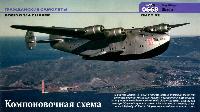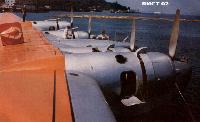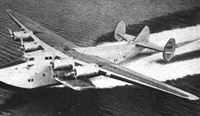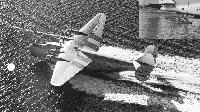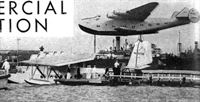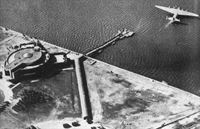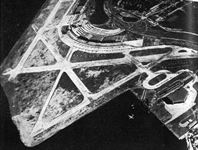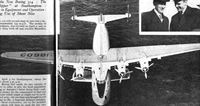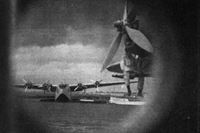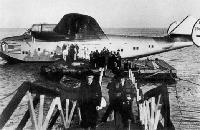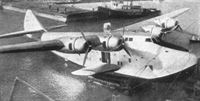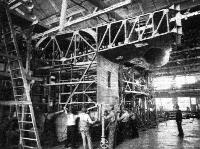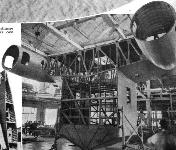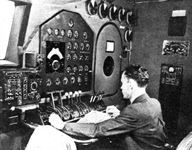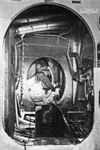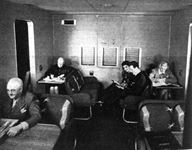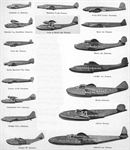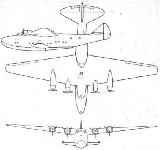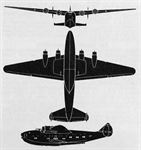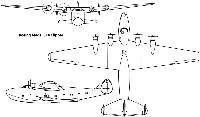
Описание
Страна : США
Год : 1938
Летающая лодка
Летающая лодка большой дальности, экипаж из 10 человек
Boeing 314 Clipper
Boeing Model 314 Clipper (C-98 и B-314)
В январе 1935 года "Pan American Airways" информировала Бюро коммерческой авиации США о решении начать трансатлантические перевозки, в связи с чем компания планировала добавить к своим четырехмоторным летающим лодкам Martin M-130 и Sikorsky S-42 новую летающую лодку.
Тендер выиграла компания "Boeing", с которой 21 июля 1936 года был заключен контракт на постройку шести летающих лодок Boeing Model 314 Clipper, проектировавшейся на основе тяжелого бомбардировщика XB-15, от которого взяли крыло и горизонтальное оперение. Лодка проектировалась под максимальную взлетную массу 37 422 кг для перевозки 74 пассажиров в четырех отдельных салонах. Вместо четырех установленных на XB-15 моторов Pratt & Whitney R-1830 Twin Wasp решили поставить четыре звездообразных Wright GR-2600 Double Cyclone, позволявших развивать максимальную скорость 311 км/ч, при этом дальность полета составила около 5600 км.
Первый гидроплан Model 314 поднялся в воздух 7 июня 1939 года. Исходный вариант имел однокилевое оперение, которое позже для лучшей путевой устойчивости заменили двухкилевым - но даже после этого путевая устойчивость оставалась неудовлетворительной, пришлось добавить центральный киль, но уже в варианте без руля направления. После получения сертификата летной годности, 20 мая 1939 года летающая лодка Model 314 выполнила первый авиапочтовый рейс через Атлантику, пассажирские перевозки начались 21 июня того же года.
"Pan Am" заказала еще одну партию из шести модернизированных лодок Model 314A с двигателями Double Cyclone мощностью no 1600 л. с, оснащенными винтами большого диаметра. Кроме того, на этих самолетах увеличили запас топлива на 4542 л и изменили интерьеры салонов. Первый гидроплан Model 314A поднялся в воздух 20 марта 1941 года, поставка всей партии из шести машин была завершена 20 января 1942 года. Пять летающих лодок первой партии в 1942 году прошли модернизацию до уровня Model 314A. Три лодки второй партии продали еще до завершения их постройки авиакомпании BOAC, которая планировала использовать их на трансатлантических маршрутах и на линии Фойне (Ирландия) - Лагос (Нигерия), ставшей частью нового почтового маршрута, открытого после вступления в июне 1940 года в войну Италии и закрытия почтовых авиалиний на Средиземном море. Новая линия, связывавшая Великобританию с Ближним Востоком, Африкой, Южной Азией и Австралией, за характерный подковообразный вид маршрута на карте получила название "Horseshoe Route".
Из девяти лодок Model 314 и 314A компании "Pan Am" четыре были реквизированы Транспортным командованием ВВС Армии США и получили военное обозначение C-98. Использовались они мало, и в ноябре 1942 года были возвращены авиакомпании. Еще три лодки передали ВМС США, где они получили обозначение B-314; экипажи лодок перешли из авиакомпании "Pan Am" вместе с самолетами. B-314 частично камуфлировали, но сохранили гражданскую регистрацию.
Эксплуатация летающих лодок авиакомпаниями BOAC и "Pan Am" была прекращена в 1946 году, уцелевшие гидропланы продали небольшим американским чартерным авиаперевозчикам.
ТАКТИКО-ТЕХНИЧЕСКИЕ ХАРАКТЕРИСТИКИ
Boeing Model 314
Тип: летающая лодка большой дальности, экипаж из 10 человек
Силовая установка: четыре звездообразных мотора Wright R-2600 Double Cyclone мощностью по 1500л.с. (1118кВт)
Характеристики: максимальная скорость на высоте 3050 м - 311 км/ч; крейсерская скорость на оптимальной высоте 295 км/ч; начальная скороподъемность 172 м/мин; практический потолок 4085 м; дальность 5633 км
Масса: пустого 22 801 кг; максимальная взлетная 37422 кг
Размеры: размах крыла 46,33 м; длина 32,31 м; высота 8,41 м; площадь крыла 266,34 м:
Вместимость: до 74 пассажиров
- Boeing 314 Clipper
Фотографии
-
Мировая Авиация 227
Регистрационный номер: NC18602 [7], NX18602 [7] "California Clipper", окраска "Pan Am" мирного времени. Самолеты "Pan Am" поступили в эксплуатацию, будучи окрашенными в цвет натурального алюминия, но днище корпуса лодки было черным, а панели обшивки крыла, занимавшие почти весь размах его верхней поверхности, - ярко-оранжевые. Под кабиной размещался логотип компании в виде крылатого глобуса и большое изображение флага США. Кроме того, флаги были изображены на нижней поверхности спонсонов. На концевых килях был нанесен логотип компании "Boeing". Самолет "California Clipper" (NC18602) обслуживал тихоокеанскую линию от Сан-Франциско до Гонконга.
-
Мировая Авиация 227
Регистрационный номер: G-AGCB [3], NC18610 [3] British Overseas Airways Corporation, окраска военного времени. Самолет G-AGCB (названный "Bangor") был одним из трех Clipper компании BOAC, летавших на маршрутах в Западную Африку и через Северную и Южную Атлантику. Во время войны эти машины выполняли транспортные перевозки в интересах британского правительства. Машины получили камуфляж, стандартный для патрульных самолетов, - темно-серый и темно-зеленый цвет на верхних поверхностях и светло-серый - на нижних. Поверх него был нанесен гражданский регистрационный номер (подчеркнутый трехцветным флагом), флаг на киле, эмблема BOAC и флаг Британского Королевства.
-
Мировая Авиация 227
Регистрационный номер: G-AGBZ [10], NC18607 [10] British Overseas Airways Corporation, послевоенная окраска. После войны самолеты Clipper компании BOAC расстались с камуфляжем, быстро сменив его на окраску цвета натурального металла. Они не несли названия компании, но сохранили ее эмблему и флаг Британского Королевства. На хвостовой части фюзеляжа был нанесен регистрационный номер увеличенного размера. На рисунке представлен самолет G-AGBZ с собственным названием "Bristol".
-
Air Enthusiast 2006-07 / E.Davies - A Quiet Airman /Production and industry/
Для своего времени Clipper являлся самым надежным самолетом с наибольшей дальностью полета. Летающие лодки данного типа в годы войны часто использовались для перевозок первых лиц США и Великобритании, особенно часто летал на этих гидропланах Уинстон Черчилль, выполнивший несколько трансатлантических перелетов на машинах "Pan American" и BOAC. Снимок летающей лодки компании "Pan American" сделан во время прогонки двигателей.
A Boeing 314 'Clipper' on the water at Seattle. -
Мировая Авиация 227
Регистрационный номер: NC18602 [7], NX18602 [7] "California Clipper"(N18602) в полете на фоне знаменитого моста Золотые Ворота. Компания "PanAm" первоначально использовала эту машину и ее близнеца "Honolulu Clipper" на Тихом океане; еще четыре Clipper обслуживали линии в Атлантике. К моменту списания в 1 946 году "California Clipper" налетал более миллиона миль.
-
Мировая Авиация 49
Регистрационный номер: NC18611 Редкий цветной снимок Boeing Model 314 в полете. Огромные летающие лодки эксплуатировались, главным образом, авиакомпанией "Pan American" на тихоокеанских и трансатлантических маршрутах.
-
Air Enthusiast 2001-01 / T.Singfield - The Free Air of Heaven
Регистрационный номер: G-AGBZ [10], NC18607 [10] A rare wartime colour slide believed to have been taken by the remarkable Wing Commander Ware of BOAC's Boeing 314A G-AGBZ 'Bristol' tied up at Darrell's Island
-
Мировая Авиация 227
Во время Второй мировой войны пять самолетов Clipper были реквизированы ВМС США, присвоивших им обозначение B-314. Смотровые люки двигателей служили в качестве площадок обслуживания. Самолеты ВМС сохранили яркую оранжевую окраску на части верхней поверхности крыла, имевшуюся у гражданских машин.
-
Мировая Авиация 49
Регистрационный номер: NX18601 [11] Прототип гидроплана Model 314 имел один киль сравнительно небольшой площади. Позже однокилевое оперение заменили двухкилевым, но путевая устойчивость все равно не вошла в норму как при движении по воде, так и в полете.
-
Jane's All the World Aircraft 1980 / Encyclopedia of Aviation - 1. Chronology
Boeing 314 in original form, with single fin and rudder (20 May 1939).
-
Flight 1938-07 / Flight
Регистрационный номер: NX18601 [11] The Boeing 314 taking off from Puget Sound. Twin rudders and redesigned sponsons are being fitted as the result of initial tests.
-
Flight 1938-09 / Flight
Регистрационный номер: NX18601 [11] OUT AGAIN: The big Boeing flying boat designed for the Atlantic service is now out again for tests with its redesigned tail unit. It will be remembered that during the initial tests the directional surfaces were found to be inadequate. Presumably the sponsons have also been modified, since the machine’s stability in the water was not a strong point during taxying trials.
-
Air Enthusiast 2001-11 / E.Davies - 'Super Clipper' (1)
Регистрационный номер: NX18601 [11] NX18601 at Matthews Beach on Lake Washington. Twin rudders have replaced the original single design, but the third vertical stabiliser has yet to be added.
-
Jane's All the World Aircraft 1938 / 03 - All the world's aeroplanes
Регистрационный номер: NX18601 [11] The Boeing 314 Trans-oceanic Flying-boat (four 1,000 h.p. Wright "Cyclone" engines).
-
Flight 1938-09 / Flight
Регистрационный номер: NX18601 [11] ON TEST AGAIN: The Boeing 314 Atlantic boat flying over Seattle on test with its new twin-rudder tail assembly and modified sponsons. In this case she was loaded up to a gross weight of 77,500 lb., which is stated to be the greatest ever to be airborne over America. Included in the weight was the test pilot, Edmund T. Allen, with a crew of five assistants and test engineers.
-
Flight 1939-01 / Flight
Регистрационный номер: NX18601 [11] America’s contribution: The Boeing 314 boat, which is designed for an all-up weight ol 82,500 lb., in its latest form with redesigned sponsons and triple tail. This is the largest flying boat to be produced since the Dornier Do.X, which had an all-up weight of 113,000 lb. The Boeing is shown here flying on the two starboard engines.
-
Flight 1938-12 / Flight
AMERICA’S BIGGEST: The Boeing 314, seen here alighting on Lake Washington, Seattle, after a test flight, has now completed its manufacturer’s trials. This particular machine is the first of six being built for Pan-American Airways.
-
Aeroplane Monthly 2000-02 / J.Golley - A Clandestine Assignment /Secret ferry flights/
Этот самолет Model 314 "Dixie Clipper" компании "PanAm" величественно отрывается от воды в районе Лонг-Айленда 28 июня 1939 года. Лодка отправляется в Марсель через Азорские острова и Лиссабон, на что ей требовалось 29 с половиной часов. Большие спонсоны на корпусе не только обеспечивали устойчивость на воде, позволив отказаться от подкрыльевых поплавков, но и создавали дополнительную подъемную силу.
Pan American operated the Freetown-Miami service with Boeing 314s. -
Air International 2022-05 / T.Batchelor - A sea change?
Boeing’s 314 Clipper set the scene for financially viable flying boat services in the late 1930s
-
Flight 1939-04 / Flight
The most advanced commercial flying-boat in the air to-day is the Boeing 314, the layout which is apparent on the photo. The engines are four Wright two-row Cyclones of about 1,500 h.p. each.
-
Мировая Авиация 49
Регистрационный номер: NX18601 [11] В толще консоли крыла имелись туннели, по которым борттехники в полете могли подобраться к любому двигателю для выполнения мелкого ремонта.
-
Flight 1939-04 / Flight
Регистрационный номер: NC18603 [7] READY FOR THE CROSSING: The Boeing 314 Yankee Clipper cutting things fine while making an approach at Baltimore after flying over from San Francisco. The machine at the landing stage is the Sikorsky S.42B Bermuda Clipper, which is now being assisted on the Bermuda service by the second of the 314s, Allanite Clipper. At the time of going to press Yankee Clipper was at Biscarosse.
Другие самолёты на фотографии: Sikorsky S-42 Clipper - США - 1934
-
Мировая Авиация 65
Регистрационный номер: NC18607 [10], G-AGBZ [10] На некоторых летающих лодках Model 314 в бортовых спонсонах на уровне ватерлинии были устроены топливные баки суммарной емкостью 15899л. Спонсоны также использовались как платформы при погрузочных и разгрузочных работах.
-
Air Enthusiast 2001-11 / E.Davies - 'Super Clipper' (1)
Регистрационный номер: NC18602 [7], NX18602 [7] Shown off the coast of California during her delivery flight, the second Clipper, 'No.18', was later christened 'California Clipper’.
-
Air International 1987-03 / R.Braybrook - The Sixties, the Thirties and the American Challenge
Регистрационный номер: NC18602 [7], NX18602 [7] In the five years leading up to World War II, the US manufacturers produced a series of flying boats for long-distance commercial operation, demonstrating a substantial lead over the rest of the world. They included the Boeing 314 (shown), the Sikorsky S-42 and Martin's M-130 "China Clipper" which, in 1934, entered service to operate a transpacific airmail service.
-
Flight 1939-04 / Flight
Регистрационный номер: NC18603 [7] The side elevation lines of the Yankee Clipper are shown well in this photograph taken while the machine was making one of its pre-landing circuits over the Southampton area.
-
Flight 1940-02 / Flight
Регистрационный номер: NC18606 [3] EVEN ON THE OTHER SIDE: The American Clipper, returning to the United States, finds Baltimore harbour choked with ice. It ultimately found a clear patch on which to sit down.
-
Мировая Авиация 49
Регистрационный номер: NC18609 В годы войны летающие лодки Model 314 эксплуатировались одновременно в авиации ВМС и Армии США, в последнем случае гидропланы получили обозначение C-98. Экипажи гидропланов комплектовались из персонала авиакомпании "Pan American".
The Boeing 314-A Trans-Atlantic Flying-boat (four Wright Cyclone 709C-14AC1 engines). -
Aeroplane Monthly 1989-11 / Personal album. Civil
Регистрационный номер: NC18606 [3] The seventh Boeing 314 built, NC18606, was christened American Clipper at Reeves Field, Los Angeles Harbor, near San Pedro, on July 6, 1939. The 41-ton 314 arrived with a 12-man crew and was christened by Mrs Mark T. McKee, the wife of Pan Americans director. Afterwards the 'boat made five flights around the harbour carrying 45 guests on each flight.
-
Aeroplane Monthly 1989-11 / Personal album. Civil
PAA's inaugurial fortnightly airmail service from San Francisco to Auckland, New Zealand started on July 12, 1940 with intermediate stops at Honolulu, Cantan Island and Noumea, New Caledonia. The Honolulu Clipper is seen here after landing at San Pedro at Cabrillo Beach at 1500hr with 14 passengers on the fifth flight since the service began. On August 28, 1939 PAA announced that it was having the American flag painted on the bows and undersides of the Clippers in order to identify them as neutral in Europe.
-
Flight 1940-03 / Flight
Регистрационный номер: NC18603 [7] The Yankee Clipper, inbound from Europe, taxis past the American freighter City of Flint, docked at Baltimore after its recent famous voyage during which it was captured by a German warship and freed by Norway.
-
Flight 1939-02 / Flight
Регистрационный номер: NX18602 [7], NC18602 [7] THREE ARE OUT: An interesting picture (actually taken on January 25, 1939) from Seattle, showing three of the Boeing 314 boats moored together off Matthews Beach, Lake Washington. No. 1, in which interior fittings are now being installed, is on the left, while No. 3 (on the right) should, by now, have flown east for Atlantic experiments. Six of these boats have been ordered by Pan-American Airways.
-
Flight 1940-08 / Flight
Регистрационный номер: NC18606 [3] WELL MET! The American Clipper of Pan American Airways arrives at Auckland, New Zealand, after its flight from California. Already moored is the British Trans-Tasman flying boat Awarua, which carries the mail on to Australia.
Другие самолёты на фотографии: Short Empire / S.23 - Великобритания - 1936
-
Flight 1939-06 / Flight
Регистрационный номер: NC18603 [7] THE YANKEE CLIPPER moored near two Empire boats at Southampton after her second Atlantic crossing.
Другие самолёты на фотографии: Short Empire / S.23 - Великобритания - 1936
-
Air Enthusiast 2001-01 / T.Singfield - The Free Air of Heaven
Wartime shot of Darrell's Island with a PanAm Boeing 314 and two Flying School Luscombes on the water, with six PBYs and a Kingfisher on the island.
Другие самолёты на фотографии: Consolidated PBY Catalina - США - 1935Luscombe 8 / 50 Silvaire - США - 1938Vought OS2U Kingfisher - США - 1938
-
Flight 1940-04 / Flight
OFF TO LISBON. A Clipper leaves the seaplane base of La Guardia Field, New York, for its transatlantic flight. The incoming passengers will prefer this to Ellis Island.
-
Flight 1939-11 / Flight
NEW YORK’S NEW AIRPORT AT NORTH BEACH, L.I.: In the foreground is the seaplane base, with a Clipper at moorings. In the background can be seen the six huge hangars, of semi-circular formation.
-
Flight 1939-04 / Flight
Регистрационный номер: NC18603 [7] The Boeing at Southampton. The outlines on the wings, fuselage and sponsons evidently indicate the areas on which the crew may walk.
-
Flight 1939-12 / Flight
Регистрационный номер: NX18602 [7], NC18602 [7] One of Pan American's Boeing 314 “Clippers.” By the end of 1940 their fleet should be increased to twelve.
-
Flight 1939-11 / Flight
Регистрационный номер: NC18602 [7], NX18602 [7] THROUGH THE PORTHOLE: An unusual view of Pan American’s California Clipper berthed in Mechanics Bay, Auckland, New Zealand. The picture was taken from the Short Empire boat Aotearoa.
Другие самолёты на фотографии: Short Empire / S.23 - Великобритания - 1936
-
Air Enthusiast 2001-11 / E.Davies - 'Super Clipper' (1)
Prior to delivery, a striking view of the Boeing 314's bow photographed at night.
-
Flight 1939-07 / Flight
Регистрационный номер: NC18603 [7] INAUGURAL TERMINATION: “Observers” and official passengers transferring from the Yankee Clipper to one of Imperial's Power boats after arrival at Hythe at the conclusion of the first regular mail service across the North Atlantic.
-
Flight 1939-04 / Flight
Some idea of the size of the machine and the area of the sponsons may be gained from this photograph of the crew being taken aboard one of the Imperial Airways’ Power tenders.
-
Мировая Авиация 103
11 августа 1939г.: регулярные почтово-пассажирские полеты между США и Британией начали осуществлять английская авиакомпания "Imperial Airways" и американская "Pan American". Компания "Pan Am" использовала летающие лодки "Boeing 314" (на снимке), а "Imperial" - лодки "Short S.30". Те же компании вскоре начали регулярные пассажирские авиарейсы.
-
Air Enthusiast 2001-01 / T.Singfield - The Free Air of Heaven
Регистрационный номер: G-AGCB [3], NC18610 [3] BOAC's Boeing 314A G-AGCB 'Bangor' berthed at Darrell's Island showing its original natural metal finish and the glazed observation position above the wings.
-
Aeroplane Monthly 1985-10 / ??? - BOAC's Boeing Clippers
Регистрационный номер: G-AGCB [3], NC18610 [3] BOAC’s third Boeing 314A, G-AGCB, pictured at Baltimore, where all three UK boats were periodically returned for maintenance.
-
Aeroplane Monthly 1985-10 / ??? - BOAC's Boeing Clippers
BOAC's 314s were painted slate blue and drab olive and the Union Jack was painted on each side of the hull. The aircraft's name was painted in black and outlined in silver.
-
Aeroplane Monthly 1985-10 / ??? - BOAC's Boeing Clippers
Регистрационный номер: G-AGCA [3], NC18608 [3] Boeing 314A Berwick, G-AGCA, on the slipway.
-
Aeroplane Monthly 1985-10 / ??? - BOAC's Boeing Clippers
Регистрационный номер: G-AGBZ [10], NC18607 [10] Two photographs of Boeing 314 Bristol G-AGBZ. Note the red, white and blue stripes below the registration letters.
-
Aviation Historian 10 / R.Flude - "Some Supreme Effort..."
Регистрационный номер: G-AGBZ [10], NC18607 [10] Boeing 314A Clipper G-AGBZ (c/n 2081), named Bristol, was one of three purchased by BOAC in 1941, the others being G-AGCA Berwick and G-AGCB Bangor. All returned to the USA and reverted to their American civil identities (NC18607, NC18608 and NC18610 respectively) in April 1948.
-
Aeroplane Monthly 1985-10 / ??? - BOAC's Boeing Clippers
Регистрационный номер: G-AGBZ [10], NC18607 [10] Boeing 314 G-AGBZ Bristol, seen here in wartime guise, was operated from Poole across the Atlantic by BOAC post-war.
Boeing 314A Bristol, G-AGBZ, taking on passengers from the British Airways tender. All three BOAC 314s were withdrawn from service in 1948 and were sold to the General Phoenix Corporation of Baltimore. -
Мировая Авиация 49
Регистрационный номер: G-AGBZ [10], NC18607 [10] Летающая лодка авиакомпании BOAC выполняет взлет. Компания использовала три летающие лодки данного типа в годы войны для рейсов через Атлантику.
-
Aeroplane Monthly 1985-10 / ??? - BOAC's Boeing Clippers
Регистрационный номер: G-AGCA [3], NC18608 [3] Boeing 314A Berwick, G-AGCA, touches down at Iquoi Airport at Lagos, Nigeria.
-
Aviation Historian 14 / R.Flude - The Molotov Express
Регистрационный номер: G-AGBZ [10], NC18607 [10] Another type which made an invaluable contribution to the establishment of an air bridge between the Allied leaders was the Boeing 314A Clipper, BOAC examples of which carried Churchill to the UK from the crucial Arcadia conference in Washington in January 1942 (G-AGCA Berwick) and back to the USA for the Second Washington Conference that June (G-AGBZ Bristol, as seen here).
-
Air Pictorial 1957-11 / B.Robertson - U.S. Aircraft in the British Services 1914-1955 (9)
Three Boeing 314A flying-boats were purchased from the U.S.A. in 1941 for use on the Atlantic route.
-
Flight 1938-06 / Flight
FOR THE ATLANTIC: The first of the Boeing 314 flying boats for Pan American Airways takes the water at Seattle. The all-up weight is about 82,500 lb. (37 tons) and the engines are the new two-row Cyclones, each of which develops a maximum of 1,500 h.p. Remembering the present vogue for two, or even three rudders, the single one on this Boeing certainly seems to be on the small side. The all-up weight of the specially stressed Short boat is 52,000 lb.
-
Aeroplane Monthly 1988-01 / J.Ramsden - Seattle's crystal palace
Smaller artefacts on display in the museum include the Boeing 314 Clipper trim tab and crew uniforms from 1938.
-
Flight 1937-07 / Flight
SPAR OF A CLIPPER: A spar for the 152-foot wing of the 72-passenger Boeing Pan American Clipper (four two-row Cyclones) compared with that of a P-26A pursuit machine. The Clipper should be finished late this year. It will weigh 82,000 lb. - about twice as much as an Empire boat.
-
Flight 1937-09 / Flight
A CLIPPER TAKES SHAPE: The first of the Boeing Clippers, which will weigh twice as much as a Short Empire boat, is being assembled and should be flying in a few months. This view shows the junction of wing and hull.
-
Air Enthusiast 2001-11 / E.Davies - 'Super Clipper' (1)
The centre section, which was assembled 'upside down', has been righted and is being moved into position in one of the two main hull assembly jigs. Here it will be joined to the fore and aft sections that are already in situ.
-
Flight 1937-10 / Flight
Centre section of one of the new Atlantic Boeing boats for P.A.A.
-
Air Enthusiast 2001-11 / E.Davies - 'Super Clipper' (1)
Two Clipper hulls in the 115ft (35m) long final assembly jigs at Plant 1. The wooden scaffolding enclosed a total of half a mile (0.8km) of walkways that gave working access to the various levels round the two hulls.
-
Flight 1938-03 / Flight
Регистрационный номер: NX18601 [11] A CLIPPER SEES DAYLIGHT: Out of its massive “cocoon” of scaffolding, the hull of the first of six Boeing 314 trans-oceanic flying boats is now on the slipway at Seattle. The special beaching gear is eight-wheeled and weighs fifteen tons.
-
Air Enthusiast 2001-11 / E.Davies - 'Super Clipper' (1)
Регистрационный номер: NX18601 [11] The first of the Boeing 314s on the dock at Plant 1. The outer wing panels and engine mounts have been fitted, and the engines will be installed next. Note the single vertical stabiliser.
-
Flight 1938-04 / Flight
Регистрационный номер: NX18601 [11] Final assembly, in the open air, of the Boeing Atlantic Clipper, which will be powered with four of the new two-row, 1,500 h.p. Wrights. "Sea-wings" provide lateral stability on the water and facilitate embarkation of passengers.
-
Air Enthusiast 2001-11 / E.Davies - 'Super Clipper' (1)
Plant 1, the original Boeing factory on the Duwamish River in Seattle, where the Clippers were built. This aerial photograph shows the first of the 12 flying-boats on the dock, outside the main assembly building. The wings and empennage have been built but are still supported by wooden scaffolding.
-
Air Enthusiast 2001-11 / E.Davies - 'Super Clipper' (1)
Model A-314 pilot's instrument panel. The radio station was immediately aft of the second pilot on the starboard side, and the side facing flight engineer's panel was on the same side, aft of the radio operator.
-
Flight 1939-04 / Flight
All that the pilots need to look after; one of the control boxes in the pilots’ compartment, with the throttle levers on the left and the trimming controls and indicators on the right, with master controls for the mixture and manifold pressures. On the extreme right is a remote-control panel for intercommunication and radio homing purposes.
-
Aeroplane Monthly 1985-10 / ??? - BOAC's Boeing Clippers
Регистрационный номер: G-AGBZ [10], NC18607 [10] The two port 1,600 h.p. Wright Cyclone engines seen from the flight deck of Bristol, G-AGBZ
-
Flight 1939-04 / Flight
The picture gives an idea of the freedom and space which is available for the navigator - notice the telescopic drift-sight and the essential flying instruments on the left of the chart table.
-
Aeroplane Monthly 1985-10 / ??? - BOAC's Boeing Clippers
The flight deck was reached via a staircase from Cabin B on the starboard side. Aft of the cockpit on the starboard side was the radio officer's table.
-
Air Enthusiast 2001-11 / E.Davies - 'Super Clipper' (1)
'Control Room' of Clipper No.2, with test pilot Edmund T Allen at the controls in the first pilot's position.
LONG-RANGE SPACIOUSNESS: The photograph give a good idea of the amount of room which is available for the operating crew on the type which will be used for America’s contribution to this year’s Atlantic mail-carrying experiments. Here is a view looking forward towards the pilots’ section of the control compartment with, from left to right: Mr. E. T. Allen, the Boeing test pilot, Mr. J. E. Boudwin, of the Civil Aeronautice Authority, Capt. R. O. D. Sullivan, of Pan American Airways’ Atlantic division, and Mr. Earl Ferguson, one of the Boeing engineers - the latter at the radio operator’s “station.” On the left is ths seven-foot chart table which will be used by the navigator. -
Мировая Авиация 227
Своим успехом Clipper во многом обязан мастерству экипажей "PanAm". Они были не только экспертами в навигации в длительных полетах над водой, но и опытными моряками. На снимке: над столом наклонился капитан, командовавший летающей лодкой. По мере накопления опыта эксплуатации Clipper эта должность была упразднена, а командование было передано первому пилоту.
The necessities of sheer size and relative complication have demanded that the work of flying and navigating the Boeing 314 shall be divided between the members of a large crew, and the operating quarters in the machine have been designed with a spaciousness which permits such an arrangement to work really well. In the illustrations shows the crew’s flying quarters as a whole, with the navigator at his table on the left, the two pilots at the controls in the nose, and the radio operator and the engineer on the right. -
Aeroplane Monthly 1985-10 / ??? - BOAC's Boeing Clippers
The radio officer's and engineer officer's stations in Bristol. The navigator had the port side of the flight deck to himself. The door which gave access to the wing companion-ways to the engines can be seen above the engineer's head. The spaciousness of two stations is evident.
-
Flight 1939-01 / Flight
The flight engineers' station, with the various engine instruments and controls.
-
Flight 1939-04 / Flight
The engineer’s controls and instruments are shown in detail - complete with pencil-sharpener; among other things the engineer looks after the engine cooling flaps, manifold pressures and the automatic mixture controls.
-
Flight 1939-04 / Flight
The photograph shows the size of the engine maintenance walkways in the wing.
-
Flight 1939-09 / Flight
“The comfort, not to say luxury, of the internal arrangements of the Dixie Clipper must be seen to be believed.”
-
Мировая Авиация 227
Регистрационный номер: NC18603 [7] Boeing Model 314 Clipper. Этот NC18603 ("Yankee Clipper") был одним из девяти самолетов Boeing 314/314A, эксплуатировавшихся компанией "PanAm". Было построено только 12 летающих лодок Boeing Model 314 Clipper, но они снискали хорошую репутацию, непропорциональную их числу. Уступая по размерам американскому Hughes H-4 Spruce Goose и британскому Saro Princess, лайнер Clipper, тем не менее, был одной из выдающихся летающих лодок, когда-либо находившихся в коммерческой эксплуатации. Правда, карьера его была недолгой из-за появления в послевоенное время более эффективных сухопутных лайнеров и активному строительству ВПП в годы войны. Все это сильно сузило сферу применения летающих лодок.
-
Air Enthusiast 2001-11 / E.Davies - 'Super Clipper' (1)
Регистрационный номер: NC18601 [3] Pan American Airways System postcard of 'Yankee Clippers Sail Again', from the original painting by Gordon Grant.
-
Flight 1937-05 / Flight
Регистрационный номер: NC17633 ATLANTIC CLIPPER: Powered with four unnamed engines, undoubtedly the new 1,500 h.p. two-row Wright Cyclones, this Boeing flying boat, intended for Pan-American's transatlantic trials, should be flying this autumn. Seventy-two passengers will be accommodated over shorter distances.
-
Air Enthusiast 2001-11 / E.Davies - 'Super Clipper' (1)
Регистрационный номер: NC18607 [10], G-AGBZ [10] Cut-away showing the interior configuration of the A-314.
-
Flight 1937-10 / Flight
Регистрационный номер: NC18601 [3] A sectioned view of the Boeing 314 Super Clipper of the type which, with auxiliary tankage, is likely to be used some time next year for transatlantic experiments. The engines are four Wright two-row Cyclones of about 1,500 h.p. each.
-
Air Enthusiast 2001-11 / E.Davies - 'Super Clipper' (1)
Регистрационный номер: NC18601 [3] Cut-away showing the interior configuration of Boeing's proposed 314 flying-boat. Note the single tail and the mechanic servicing the No.1 engine, in flight.
-
Flight 1938-04 / Flight
Другие самолёты на фотографии: Bloch MB.160 Languedoc - Франция - 1937Consolidated PBY Catalina - США - 1935Dewoitine D.332 / D.333 / D.338 / D.620 - Франция - 1933Douglas DC-3 / C-47 Skytrain/С-53 Skytrooper / Dakota - США - 1935Douglas DF - США - 1936Focke-Wulf FW.200 Condor - Германия - 1937Junkers Ju.86 - Германия - 1934Latecoere Late 631 - Франция - 1942Liore et Olivier LeO H.246 - Франция - 1937Lockheed Super Electra 14 - США - 1937Martin Russian Clipper / Type 156 - США - 1937Potez Potez 661 - Франция - 1937Potez-CAMS Potez-CAMS 160 / 161 - Франция - 1938Savoia-Marchetti / SIAI SM.83 - Италия - 1937Sikorsky S-43 Baby Clipper/JRS/Y1OA-8 - США - 1936Sud-Est SE.200 - Франция - 1943
-
Flight 1937-10 / Flight
General arrangement of the Boeing 314 flying boat.
-
Air Enthusiast 2001-11 / E.Davies - 'Super Clipper' (1)
General arrangement drawings from the Boeing 314 maintenance manual.
-
Jane's All the World Aircraft 1946 / 03 - All the world's aeroplanes
The Boeing 314-A Clipper Flying-boat.
-
Мировая Авиация 65
Boeing Model 314 Clipper
- Фотографии




